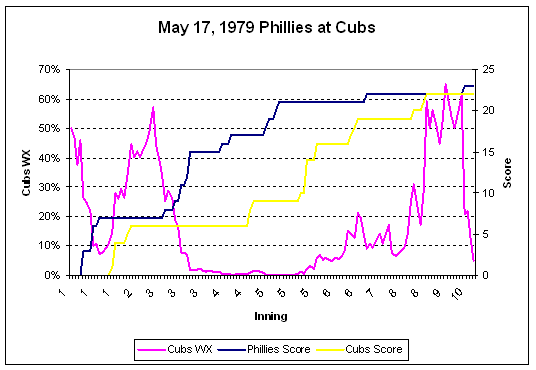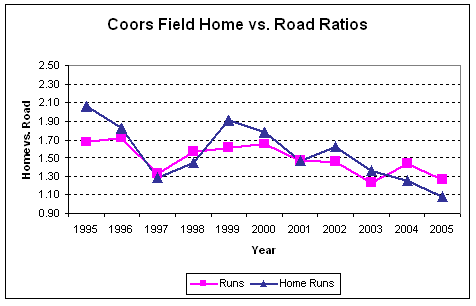BP Comment Quick Links

 | |
June 8, 2006 Schrodinger's BatSwing and Miss
"Things could be worse. Suppose your errors were counted and published every day, like those of a baseball player."
Every fan knows that Babe Ruth struck out over 1,300 times to go along with his 714 home runs. Pete Rose made almost 10,000 outs in his career. And last week SABR members enjoyed a lively discussion on the their listserve discussing the players who made the most outs in a season (a hint: "Omar the Outmaker" takes three of the top ten spots). Failure is inherent in the game, a fact that George Will, in a recent interview with our own Will Carroll, credits with making baseball "especially suited for a nation in which the politics are democratic." This is so because the game, like our republic, requires both the patience to endure that failure and the compromise of "settling for the half loaf." After all, even the best hitters fail 65% of the time, and the best teams lose 60 times per season. Those who write about the game certainly strive to hit the mark in excess of 65% of the time, but from time to time we too strike out. So this week, we'll look at three swinging strikes from your humble author to go along with a quick take on the humidity of the front range. Strike One: Posada's Prowess In each of the last two columns I referenced Jorge Posada's May 17th homerun to cap the Yanks 14-13 comeback. And both times I mentioned that the Yankees probability of winning before the homerun was 46% making Posada's blow worth 54% in terms of WX. Several readers, and our own Rany Jazayerli, quickly pointed out the absurdity of that notion. Reader Bill Watson-Canning put it this way:
Well said. In fact, the WX for the Yankees at that point was actually 14.9%, and not 46%, making Posada's homer worth 85.1%. As Bill intuits, the Yanks WX with zero outs was in fact 46%. That's what happens when you put a '0' where a '2' should be. Strike Two: The Walk-Off This point gives us the opportunity to address walk-off home runs. The column relating high impact performances listed the five largest-impact plays of 2005. Unfortunately, the methodology used did not account for walk-off home runs, and as a result I missed these plays that would have been within the top five, and which I'm sure many readers will remember (whether fondly or not).
Strike Three: Missing Comebacks After the column on comebacks was published last week, I received plenty of emails from readers who attended specific games. Many of those relived the joy, frustration, and amazement that such games produce, and so I thank those who took the time to write in. However, several readers noted a couple other games that didn't make my list and which, after a little digging, I discovered had been omitted. Without further adieu, here are three more big comebacks and one that failed but is close to my own heart.
The Phillies scored eight more runs in the third and two in the fourth to make it 17-6. The Cubs then mounted a furious comeback with three runs in the fourth (on another Kingman homer) and seven in the fifth--the big blows were a Buckner grand slam followed by a Mike Vail two-run homer. I distinctly recall our family hearing the Vail home run on WGN radio (we lived in eastern Iowa and therefore did not receive WGN-TV), and being amused as the Cubs announcer rejoiced afterwards with the phrase "now the Cubs are only five behind!" Despite our incredulity, the Cubs scored three more runs in the eighth after the Phils tacked one on in the 7th and tied the score at 22. Mike Schmidt, always a Cubs nemesis, finally won the game in the 10th on a solo home run (his second of the day) off of Bruce Sutter. The mayhem was over after four hours, 50 hits, and 11 home runs--three hit by Kingman alone. The low point for the Cubs occurred with two outs in the top of the fifth, with the Phillies threatening and a 21-9 lead putting their WX at .15% (1 in 662). Although the Cubs lost, it'll always be a game I remember fondly.
 One of the interesting things about this particular game from a WX perspective is the consideration of run environment. The calculations for this article were done based on the average runs scored per game at Wrigley Field in 1979. However, the weather conditions that day obviously served to greatly increase the run environment just for that day, and so a more accurate calculation would need to adjust the environment on a game-by-game basis. That opens the Pandora's box of applying custom run environments based not only on weather but on starting pitchers, all the way down to granular conditions including specific match-ups for each at bat (one reader made that very point when analyzing the Indians 2001 comeback against the Mariners in detail). Hey, I'm all for the reductionist approach, at least where baseball is concerned, but you can see how this could quickly get out of hand. It's Not So Much the Heat, it's the Humidity But let's move on to something a little more relevant to this season. Here in the shadow of the Rocky Mountains the talk has turned to humidity (at least before yesterday's 16-9 Rockies victory over the Pirates). A spate of articles at the end of May both locally and in the national media have recounted the fact that Coors Field seems to be playing as more of a neutral park this year, and Kent Mercker even chimed in by saying, "I like pitching here. This park has become one of the best pitchers' parks." Most of the stories done on this topic at some point mention that it looks like the humidor the Rockies use to store baseballs and installed after the 2001 season is finally "kicking in." Because the Rockies have said that they've always stored the balls at 70 degrees Fahrenheit and 50 percent humidity, and continue to do so, one might find it hard to believe that only now would the humidor's effects be felt. To see whether this season is truly an outlier, let's start by considering the following graph which shows the ratio of home versus road scoring and home runs per out made for the Rockies and their opponents from 1995-2005.
 What the graph indicates is that for three consecutive years prior to this season, home runs have declined at Coors relative to road games, while run-scoring had held basically steady since 2001 (with some year-to-year variance). However, it is clear that the 1995-2000 period was different from the 2001-2005 period, and so one could certainly argue that the humidor has played a role in that despite the fact that offensive levels were up in 2002 relative to 2001. However, it should be noted that with the opening of Minute Maid Park in 2002, Great American Ballpark in 2003, and Citizen's Bank Ballpark in 2004, the advantage that Coors Field had has shrunk relative to the league. More hitter's parks raise the league's overall level, making Coors less extraordinary. But where does 2006 stack up? Through games of June 4th, run-scoring stood at .99 and home runs at 1.10. In other words, through last weekend Coors was playing basically league-neutral in terms of run scoring and about 10% higher in terms of home runs. Of course, this includes just 26 home and 30 road games. Because of the small sample size, one might imagine that what we're seeing is the effect of early-season weather in Denver, which can be very cold and windy and therefore depress run scoring. To see whether early season weather may be a factor, we can restrict our view to games played through May 31st of each season, as shown in the graph below.
 You'll notice that there is obviously more variability when looking at so few games, but what shows up is that 2006 has indeed been by far the lowest through the early part of any season. Only 2002 approaches this year, when run scoring was at 1.12 and home runs at 1.28, still 12% and 14% higher respectively. So it would appear that something has indeed changed. Although we don't at this point have definitive answers, we might speculate that there are least three factors that may be playing a role.
In the end it may be too early to say anything definitive, but it certainly appears as if playing at altitude is not what it used to be.
|